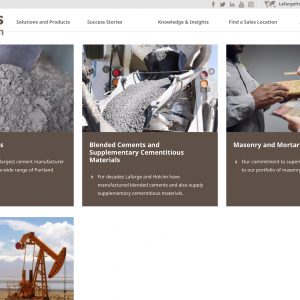LafargeHolcim’s latest sustainability report outlines the economic, environmental and social performance of the company. It also presents objectives for its four strategic sustainability pillars: climate & energy, circular economy, environment and community.
 In 2018, LafargeHolcim’s net CO2 emissions per tonne of cementitious material decreased to 576 kg CO2/tonne, a 1% reduction from 2017 and equal to a 25% reduction compared with 1990 emissions. This exceeds the company’s year-on-year reduction objective and positions it to deliver on a new carbon reduction target of 520 kg CO2/tonne by 2030. The improvement was achieved by reducing the clinker-to-cement ratio and consuming less energy per tonne of cement, mostly by using alternative fuels and improving process efficiency.
In 2018, LafargeHolcim’s net CO2 emissions per tonne of cementitious material decreased to 576 kg CO2/tonne, a 1% reduction from 2017 and equal to a 25% reduction compared with 1990 emissions. This exceeds the company’s year-on-year reduction objective and positions it to deliver on a new carbon reduction target of 520 kg CO2/tonne by 2030. The improvement was achieved by reducing the clinker-to-cement ratio and consuming less energy per tonne of cement, mostly by using alternative fuels and improving process efficiency.
Last year, the company treated 52 million tonnes of waste, a 6% increase from 2017. More than 11 million tonnes – an increase of 10% over 2017 – were used by Geocycle, the company’s global waste management business, as a fuel for kilns or as alternative raw materials using co-processing technolo
In addition, the company recovered an additional 41 million tonnes of waste, mainly byproducts from other industries, such as slag from the steel industry and fly ash from power generation, to replace clinker in the final cement product. Reducing the clinker content in cement allows LafargeHolcim to limit the CO2-intensity of its cement production.
In the report, the company said it has reduced water withdrawal in cement plants by around 19% over the last four years. LafargeHolcim will now shift its focus to consider its total impact on water resources in the communities where it operates, particularly in water-scarce areas. In consequence, the company will revise its ambitions to reflect water impact, which it intends to reduce by focusing on the most vulnerable areas of operation.
Lastly, LafargeHolcim reports 2.9 million people benefited from its community programs worldwide in 2018 – with over 15 million having benefited over the last four years.

